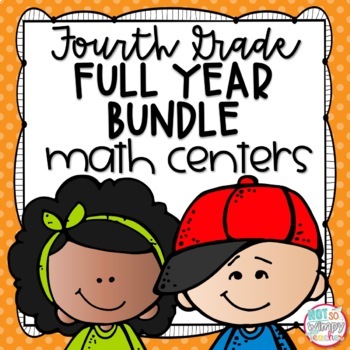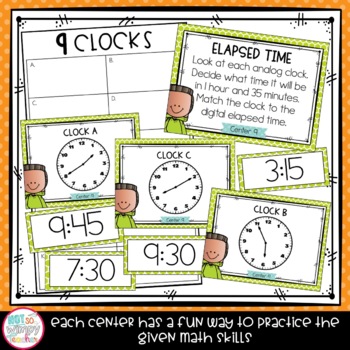Math Centers Bundle FOURTH GRADE
- Zip
What educators are saying
Products in this Bundle (10)
showing 1-5 of 10 products
Bonus
Also included in
- This bundle includes EVERYTHING you need to teach math workshop in fourth grade including lesson plans, interactive mini-lessons, student printables, small-group activities, assessments, project-based learning activities, a complete fact fluency program with mixed-fact practice, and 90 done-for-youPrice $247.50Original Price $334.50Save $87.00
Description
This 4th grade bundle includes hands-on and engaging math centers for the entire year!!! You will be getting a total of 90 math centers!
Each set of centers has the same format, so students will learn the expectations and procedures and then be able to complete centers for the entire year without many new directions.
*********
I also have this resource in a digital version! Click HERE to check it out.
The centers are engaging and include sorts, task cards, color coding, math writing, matching, etc. Each set of centers has a recording book that students use for all 10 centers in that unit.
Centers are included in color and black line for your convenience.
JUST ADDED! This bundle now includes a 40 page document with math center tips, schedules, posters, and labels!
************
This resource is part of a money-saving MEGA bundle. Click HERE to see the entire bundle.
************
Centers Included:
1. Math journaling
2. Word problem task cards
3. Addition & Subtraction (with regrouping)
4. Rounding to the Nearest 10 & 100
5. Area and Perimeter
6. Graphs (Bar Graph and Picture Graph)
7. Multiplication Chart Patterns
8. Missing Factors
9. Clocks to the Nearest Minute
10. Comparing and Equivalent Fractions
1. Math journaling
2. Mystery Number task cards
3. Rounding to the nearest 100
4. Rounding to the Nearest 1,000
5. Making Numbers (greatest and least value)
6. Expanded form
7. Comparing Numbers
8. Multiplying and dividing by 10
9. Digit Value
10. Writing the mystery number problem
1. Math journaling
2. Word Problems (2 digit x 2 digit and 3 digit x 1 digit)
3. Prime or Composite?
4. Multiples
5. Mystery Numbers (using factors)
6. Comparisons (Ex: 144 is 12 times as many as___)
7. Vocabulary
8. Area Models (You can substitute a different strategy if needed.)
9. Multiple Digit Equations
10. Write your own word problem
1. Math journaling
2. Word Problems
3. Remainder Sort
4. True or False? (Are the equations correct? Includes equations with and without remainders.)
5. Multiplication or Division? (Word problem task cards.)
6. Quotient Sort
7. Vocabulary
8. Missing Factor Multiplication Equations
9. Long Division Equations (without remainders)
10. Write your own word problem (given a certain dividend and quotient)
1. Math journaling
2. Word Problems (Addition, Subtraction and Multiplying a Fraction by a Whole Number)
3. Comparing Fractions to One-Half
4. Matching fractions with Tenths to their Equivalent Hundredths Fraction
5. Mystery Fraction Word Problems
6. Equivalent Fraction Sort
7. Vocabulary
8. Multiplying Fractions by Whole Numbers
9. Rolling Fractions (Converting Improper Fractions to Mixed Numbers)
10. Write your own word problem (given a certain answer)
1. Math journaling (Explaining the difference between a whole number and decimal)
2. Word Problems (Addition and subtraction to the hundredth)
3. Roll a Problem (Value of a decimal and addition of decimals)
4. Rounding to the nearest whole number
5. Making Numbers (making the largest and smallest value with decimals)
6. Expanded Form
7. Color Coding (comparing fractions and decimals to one-half)
8. Comparing decimals
9. Value of digits
10. Word Form
1. Math journaling (Area and Perimeter of a Square)
2. Word Problems (Real World Area and Perimeter Problems)
3. Roll a Problem (Drawing Shapes with a Given Area and Perimiter)
4. Drawing Shapes with a Given Area
5. Vocabulary Match
6. Solving for Area and Perimeter Task Cards
7. Color Coding (units of measurement)
8. Measurement Conversions (standard and metric)
9. Elapsed Time
10. Write the Problem (Area and Perimeter)
1. Measuring Angles and Classifying as Acute, Right or Obtuse (Color code)
2. Sorting Attributes or Triangles and Squares (Color code)
3. Lines of Symmetry
4. Drawing (lines, angles, parallel lines and perpendicular lines)
5. Additive Angles
6. Shape Attributes
7. Grouping Shapes by Attributes
8. Drawing Angles with a Given Measurement
9. Vocabulary Sort
10. Math Journal (symmetry)
1. Equivalent Fractions (Color Code)
2. Prime or Composite Sort
3. Addition and Subtraction of Decimals
4. Word Problems
5. Measuring Angles
6. Area and Perimeter
7. Multiplication (2 and 3-digit)
8. Division
9. Vocabulary Sort
10. Math Journal (Decimals)
Looking for these centers for another grade level?
You might also like:






